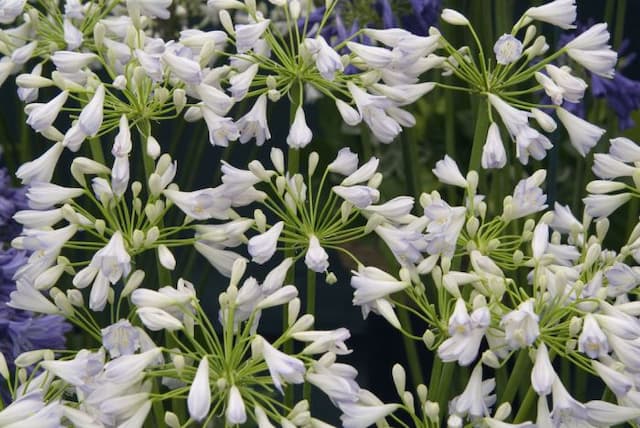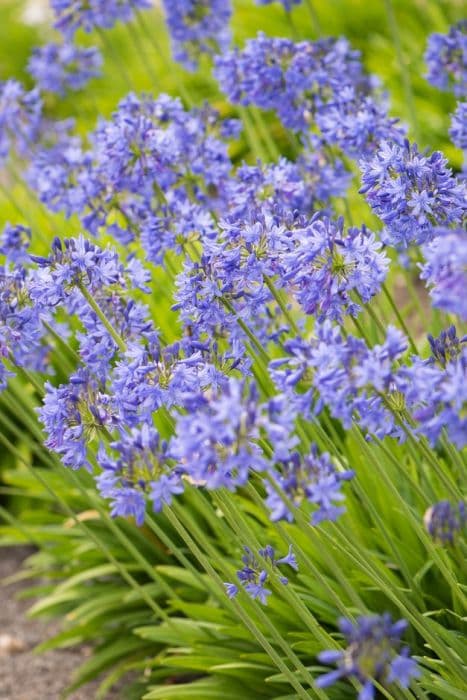Lily of the Nile Agapanthus 'Midnight Blue' ambig.

ABOUT
Agapanthus 'Midnight Blue', commonly known as Lily of the Nile, is an ornamental plant noted for its striking deep blue, almost purple flowers. The plant features lush green, strap-like foliage that forms a dense clump, elegantly arching and providing a rich backdrop for the bloom display. These leaves are deciduous or evergreen depending on the climate, contributing texture and color to the garden year-round. The flowers of the 'Midnight Blue' emerge on tall, upright stems that rise gracefully above the foliage. The blooms themselves are arranged in large, round clusters known as umbels, which have a globular and captivating appearance similar to fireworks when viewed from a distance. Each individual flower within the cluster is trumpet-shaped, featuring a dark blue to purple hue that is rich and eye-catching. The contrast of the dark blooms against the bright green leaves makes this particular variety of Agapanthus a sought-after plant for gardeners looking to add a splash of vibrant color to their landscape. In addition to its aesthetic appeal, the flowers of the Lily of the Nile hold a certain allure for pollinators such as bees and butterflies, making it not only a visual highlight but also an ecologically beneficial addition to any garden.
About this plant
 Names
NamesFamily
Amaryllidaceae
Synonyms
African Lily, Lily of the Nile, Love Flower
Common names
Agapanthus 'Midnight Blue'
 Toxicity
ToxicityTo humans
The Lily of the Nile, Agapanthus 'Midnight Blue', is known to contain compounds that can cause mild to moderate toxicity if ingested. In humans, consuming parts of the plant may result in symptoms such as nausea, vomiting, abdominal pain, and diarrhea. In rare cases, it may also cause dermatitis when the skin comes in contact with the sap. It is advised to avoid eating any part of the Lily of the Nile and to handle it with care to prevent potential skin irritation.
To pets
The Lily of the Nile, Agapanthus 'Midnight Blue', is toxic to pets. If a pet ingests parts of this plant, it may exhibit symptoms such as nausea, vomiting, diarrhea, and abdominal pain. In some cases, more severe reactions can occur. It is important for pet owners to keep their pets from eating or chewing on any part of the Lily of the Nile, as it can be harmful to their health.
 Characteristics
CharacteristicsLife cycle
Perennials
Foliage type
Evergreen
Color of leaves
Green
Flower color
Deep blue
Height
2 feet (0.61 meters)
Spread
2 feet (0.61 meters)
Plant type
Herb
Hardiness zones
8
Native area
South Africa
Benefits
 General Benefits
General Benefits- Ornamental Appeal: Agapanthus 'Midnight Blue' adds aesthetic value to gardens with its deep blue flower clusters and lush, strappy leaves.
- Low Maintenance: It requires minimal care once established, making it suitable for gardeners of all skill levels.
- Drought Tolerance: Once established, it is relatively drought-tolerant, reducing the need for frequent watering and making it suitable for water-wise landscapes.
- Long Blooming Season: It offers a long season of blooms, often from early summer to fall, providing extended color in the garden.
- Attracts Pollinators: The flowers attract bees, butterflies, and other pollinators, supporting local ecosystems.
- Deer Resistance: It is generally resistant to deer, which helps to prevent damage to the plant in areas where deer are prevalent.
- Versatility: Can be used in container gardens, borders, and as cut flowers, offering a variety of landscaping and decorative uses.
 Medical Properties
Medical PropertiesThis plant is not used for medical purposes.
 Air-purifying Qualities
Air-purifying QualitiesThis plant is not specifically known for air purifying qualities.
 Other Uses
Other Uses- Flower Arranging: The striking deep blue flowers of the Lily of the Nile can be used as cut flowers in floral arrangements, adding a touch of elegance and dramatic color to bouquets.
- Aquatic Garden Accent: Although not a water plant, the Lily of the Nile can be planted around ponds or water features to provide a lush, tropical look.
- Photography Prop: Its distinctive flowers can serve as an excellent prop or background subject for photographers looking to capture the beauty of nature.
- Garden Borders: With its clumping habit and grass-like foliage, the plant can be used as an attractive border in garden design to define spaces or line walkways.
- Fabric Dyeing: Historically, some species with similar blue flowers have been used for natural fabric dyeing, and the Lily of the Nile may lend itself to such uses for deep blue hues.
- Artistic Inspiration: The unique shape and color of the blooms can inspire artists and craftsmen, leading to botanical illustrations, paintings, or even detailed metalwork and jewelry designs.
- Theme Gardens: Lily of the Nile can be included in a midnight or moonlight garden theme due to its deep blue coloration that can appear near black in certain lights.
- Landscape Focal Point: The deep blue flowers paired with the plant's statuesque profile make it a dramatic focal point in any landscape design.
- Educational Tool: Can be used in educational settings to teach about plant biology, pollination, and botany — particularly in courses focusing on ornamental horticulture.
- Privacy Screening: When planted in a dense row, the Lily of the Nile can provide a moderate amount of privacy to a ground-level patio or garden due to its foliage and bloom height.
Interesting Facts
 Feng Shui
Feng ShuiThe Agapanthus, commonly known as Lily of the Nile, is not traditionally used in Feng Shui practice.
 Zodiac Sign Compitability
Zodiac Sign CompitabilityThe Lily of the Nile is not used in astrology practice.
 Plant Symbolism
Plant Symbolism- African Lily - The Agapanthus 'Midnight Blue', commonly known as the African Lily, often symbolizes love letters or love messages, as the name Agapanthus comes from the Greek words 'agape' meaning love, and 'anthos' meaning flower.
- Beauty - With its striking dark blue to purple flowers, the African Lily is frequently associated with beauty and elegance, making it a popular choice in decorative floral arrangements and gardens.
- Endurance and Survival - The African Lily is known for its toughness and ability to thrive in harsh conditions. It's often used to represent endurance, survival, and perseverance through challenging circumstances.
- Fertility and Prosperity - In some cultures, the lush and plentiful blooms of the African Lily are seen as symbols of fertility and prosperity, suggesting abundance and well-being.
- Freedom - Due to its growth pattern and the way its flowers seem to burst open, it can also symbolize freedom and the release of emotions or restrictions.
 Water
WaterLily of the Nile, commonly known as Agapanthus 'Midnight Blue', should be watered generously during its active growth season in spring and summer. Providing water once a week, amounting to about one to one and a half gallons per plant, will ensure adequate moisture. As the plant enters dormancy in the fall, reduce watering to every other week. Throughout the winter months, minimize watering to just enough to prevent the soil from completely drying out, perhaps as little as half a gallon every couple of weeks. Always check the top inch of the soil before watering; if it feels dry, it’s time to water.
 Light
LightLily of the Nile thrives in full sun to partial shade. The ideal spot offers at least 6 hours of direct sunlight daily. Although they can tolerate some shade, the best flowering is achieved in a location where the plant is exposed to ample sunlight. Avoid deep shade, as it can lead to reduced blooms and weaker growth.
 Temperature
TemperatureLily of the Nile prefers temperate climates and can survive in temperatures as low as 20°F, but it thrives in areas where the temperature ranges between 50°F and 80°F. Frost can damage the foliage and blooms, so in regions with severe winters, it is best to provide some protection or move potted plants indoors.
 Pruning
PruningPrune Lily of the Nile to remove spent flower stalks and encourage a tidy plant appearance. This task is typically done in late summer or fall, after the blooming period is over. Lightly shaping the plant by trimming away any dead leaves or old foliage can be done in late winter or early spring before new growth starts. It is not necessary to prune regularly, but tidying up the plant can promote better blooms the following season.
 Cleaning
CleaningAs needed
 Soil
SoilThe Lily of the Nile, or Agapanthus 'Midnight Blue', thrives in well-draining soil that is rich in organic matter. A good soil mix for this plant would be two parts loam to one part peat and one part perlite or sand to ensure good drainage. The soil pH should be slightly acidic to neutral, around 6.0 to 7.0, for optimal growth.
 Repotting
RepottingLily of the Nile, or Agapanthus 'Midnight Blue', generally requires repotting every two to three years. It's best to repot in the spring, before the growing season begins, when the plant has outgrown its current container.
 Humidity & Misting
Humidity & MistingLily of the Nile prefers moderate humidity levels; however, it is quite adaptable and can tolerate the humidity levels typically found in an average home or garden setting. There is no need for additional humidity control measures.
 Suitable locations
Suitable locationsIndoor
For Lily of the Nile, provide bright light and good air circulation indoors.
Outdoor
Plant in full sun to light shade with well-draining soil outdoors.
Hardiness zone
8-10 USDA
 Life cycle
Life cycleThe life of the Agapanthus 'Midnight Blue', commonly known as the African Lily, begins with seed germination, which occurs in warm, well-drained soil with ample sunlight. After germination, seedlings develop into juvenile plants with elongated strap-like leaves. As the plant matures, it forms an evergreen perennial clump that grows larger each year. The African Lily produces tall flower stalks in the summer, bearing deep blue to purple globular flower clusters at their tips. Following pollination by insects, the flowers develop into seed capsules, which when dry, release seeds to propagate the next generation. In colder climates, the plant may die back to the ground in winter but will resprout from its rhizomatous root system when warm temperatures return.
 Propogation
PropogationPropogation time
Spring to early summer
The Agapanthus 'Midnight Blue', often known as the African Lily, is commonly propagated through division. The best time for this is in the spring after the threat of frost has passed but before new growth begins in earnest. To propagate through division, the grower should carefully lift the plant from the ground, making sure to keep a generous amount of soil around the roots to minimize shock. Using a sharp knife or spade, the clump is then divided into smaller sections, each with a portion of the roots and at least one or two growing points. These divisions are then replanted at the same depth they were growing previously, ensuring they are spaced about 12 to 18 inches (approximately 30 to 45 centimeters) apart to allow for adequate growth and airflow. Watering the new divisions thoroughly after planting is crucial to help reestablish the plants. This method is favored for its simplicity and the speed with which new plants can become established.









